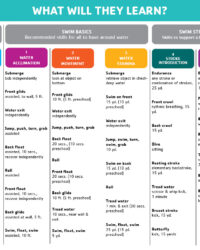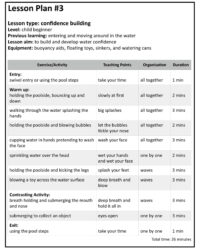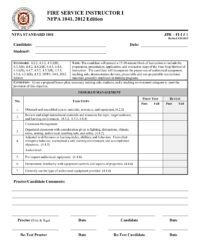Learning to swim is more than just a fun activity; it’s a vital life skill that provides safety, confidence, and a lifetime of enjoyment. Whether you’re a parent teaching your child, a volunteer instructor, or a professional swim coach, having a clear, structured plan can make all the difference in delivering effective and engaging lessons. Without a roadmap, it’s easy to lose focus, leading to less productive sessions and slower progress for the learner.
That’s where a well-designed learn to swim lesson plan template comes into play. It helps you organize your thoughts, set realistic goals, track progress, and ensure every moment in the water is purposeful. It’s like having a script for a play, guiding you through each act and ensuring all the necessary elements are covered, from safety protocols to skill development and, importantly, making sure everyone is having a good time.
Crafting the Perfect Swim Lesson Structure
Building an effective swim lesson involves more than just getting in the water; it requires thoughtful planning and a clear understanding of skill progression. A solid structure ensures that learners build confidence and ability step by step, rather than feeling overwhelmed. Think of it as constructing a house: you need a strong foundation before you can add walls and a roof. This foundation in swimming begins with water comfort and basic safety, gradually moving towards more complex strokes.
Your lesson plan should always start with a brief warm-up, both physical and mental, to prepare the body and focus the mind. This could involve simple stretches or some light splashing and getting faces wet. Following the warm-up, it’s crucial to revisit previous skills to reinforce learning and build muscle memory. This recap helps solidify what they’ve already learned, boosting their confidence for new challenges.
Next comes the introduction of new skills. This is where the core of your lesson truly shines. Break down complex movements into smaller, manageable parts. For instance, teaching freestyle might start with just kicking, then adding arm movements on the side of the pool, and finally integrating breath control. Demonstrations are incredibly powerful, showing learners exactly what you want them to do. Provide clear, concise instructions and plenty of opportunities for practice.
Remember to incorporate games and fun activities throughout the lesson. This is especially important for younger learners, as play keeps them engaged and reduces any potential anxiety about the water. Something as simple as blowing bubbles like a whale or retrieving submerged toys can reinforce breath control or underwater exploration without them even realizing they’re practicing a skill. Always end your lesson with a cool-down period and a positive recap of what was achieved, celebrating successes, no matter how small.
Essential Components of Every Swim Session
Every successful swim lesson, regardless of the learner’s age or ability, should incorporate a few key elements to ensure a comprehensive and enjoyable experience. These components act as pillars supporting the overall learning journey.
- Safety Briefing: Always begin with a quick review of pool rules and safety procedures. This sets a serious tone for safety and reinforces the importance of listening and following instructions.
- Warm-up: Gentle stretches and light water play to get muscles ready and minds focused.
- Skill Review: Revisit previously taught skills to reinforce learning and ensure retention.
- New Skill Introduction: Clear demonstration and breakdown of new techniques.
- Drills and Practice: Ample time for learners to practice new skills with constructive feedback.
- Games and Activities: Incorporate fun elements to maintain engagement and apply skills playfully.
- Cool-down and Recap: A calm period to wind down and discuss what was learned and achieved.
Addressing Different Learning Styles
Not every learner grasps concepts in the same way. Some are visual, needing to see the action demonstrated. Others are auditory, benefiting from clear verbal instructions and explanations. Still others are kinesthetic, learning best by doing and physically experiencing the movement. A good learn to swim lesson plan template will account for these variations by incorporating a mix of teaching methods. Use verbal cues, visual demonstrations, and hands-on adjustments to cater to everyone in your class, ensuring that no one is left behind.
Adapting Your Lesson Plan for Various Age Groups
One of the most crucial aspects of teaching swimming is understanding that a one-size-fits-all approach simply doesn’t work. What engages a toddler will bore a teenager, and what challenges an adult might overwhelm a young child. Therefore, adapting your learn to swim lesson plan template to suit the specific needs, attention spans, and developmental stages of your students is absolutely essential for effective and enjoyable instruction.
For toddlers and preschoolers, lessons should be short, frequent, and highly play-oriented. Their attention spans are limited, so sessions packed with songs, games, and colorful toys will keep them engaged. The focus here is primarily on water comfort, submersion, breath control, and basic propulsion like kicking. Safety is paramount, and parent involvement can be incredibly beneficial. The aim is to build a positive association with water, not to teach perfect strokes immediately.
School-aged children, typically 6-12 years old, can handle longer lessons and more structured skill development. They are capable of understanding more complex instructions and can focus on refining specific techniques. This is where you can introduce proper stroke mechanics, diving, and advanced water safety skills. Competition and group activities can also be excellent motivators for this age group, fostering a sense of achievement and teamwork.
Adult learners often come with varied experiences and motivations, sometimes carrying fears from childhood or simply wanting to learn for fitness or leisure. Their lessons should be tailored to their individual goals and comfort levels. Progress might be slower as they overcome ingrained habits or anxieties, but their motivation is typically higher. Focus on clear, detailed explanations and emphasize the practical benefits of each skill. Patience and positive reinforcement are key, helping them build confidence at their own pace.
Here are some key considerations when adapting your plan:
- Lesson Duration: Shorter for younger children, longer for older kids and adults.
- Teaching Methods: Play-based for toddlers, structured drills for school-agers, problem-solving for adults.
- Skill Progression: Basic water comfort first, then foundational skills, then advanced strokes.
- Communication Style: Simple and repetitive for young children, detailed for adults.
- Motivational Tools: Toys and songs for little ones, challenges and personal goals for older learners.
Developing a robust and adaptable learn to swim lesson plan template is truly a game-changer for anyone involved in teaching this life-saving skill. It transforms a potentially chaotic session into a structured, progressive, and enjoyable learning experience for everyone involved. By carefully planning each step, from water acclimation to mastering complex strokes, you empower learners to develop confidence, competence, and a lifelong love for being in and around water.
Remember that flexibility is key, even with the best plan. Be prepared to adjust your activities based on the energy levels and progress of your students. A well-prepared instructor, armed with a thoughtful plan, creates an environment where every splash contributes to growth, turning fear into fun and uncertainty into skill.


